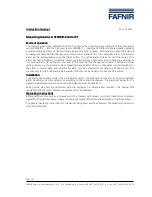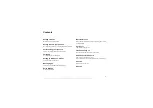
System Calibration
For best results the following test patterns will be required:
•
A crosshatch pattern with one pixel wide vertical and one pixel
high horizontal lines.
•
Standard SMPTE color bars.
•
A full width one on/one off burst pattern.
These test patterns will need to be output from the source equipment
(computer, DVD player, etc.) that you intend to connect to the Twister
Transmitter.
If possible, perform a display calibration without the Twister by connect-
ing the source directly to the display device using a short (less than 25
foot) video cable. Use the burst pattern to set the display size, phase and
pitch as per the display manufacturers instructions. Most displays will
have an “auto sync” function that will get you close, but might require
some additional fine-tuning. Once the display is set, connect the source
and display to the Twister.
Set the “EQ” adjustment to the minimum (full CCW) setting. If using the
MMTP-200S skew compensated receiver, make sure the delay settings
for R, G, and B are all at “0” (fully CCW). Using the crosshatch test pat-
tern, slowly increase the EQ setting until the vertical lines are nearly as
bright as the horizontal lines. In general, you will have to set the vertical
lines a little dimmer than the horizontal or you will have too much peak-
ing. You can check for over peaking by using the SMPTE color bars and
looking for two or three overly bright vertical lines at the beginning of
each color transition. If this occurs, back the EQ pot off slightly.
Once you are happy with the EQ setting, set the delay skew if available.
The object of the delay skew adjustment is to merge the separate red,
green, and blue vertical lines into a solid white line. Using the crosshatch
test image, identify the left most color in each vertical line of the im-
age. Use the corresponding rotary adjustment on the Twister to merge
this color with the right most vertical line in the image. Then adjust the
remaining color to merge with the first two. Once you have adjusted the
skew, use the burst pattern to fine-tune the display phase adjustment.
These last two steps may be repeated to optimize the image quality.
DC Restoration Jumpers
The MMTP-100 transmitter is equipped with DC restoration for compat-
ability with AC coupled sources. This feature relies on the presence of
a TTL compatible H sync signal applied to the H sync input pin (pin 13
of the HD-15 input connector). If you are transmitting a signal that does
not have a TTL H sync signal, you must disable the DC Restore circuit by
setting the three jumpers inside the transmitter as shown in the diagram
below. With the power to the unit dis-connected, simply remove the two
cover screws and cover on the MMTP-100 transmitter to access the three
jumpers.
DC RESTORE ENABLED
(FACTORY DEFAULT)
DC RESTORE DISABLED
JUMPERS
JUMPERS
(CHASSIS COVER REMOVED)
MMTP-100 TRANSMITTER PARTIAL TOP VIEW
























